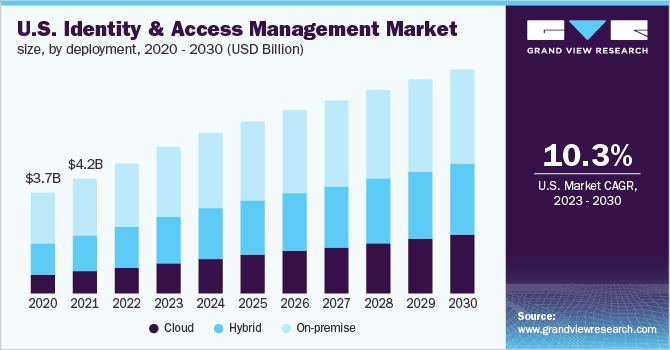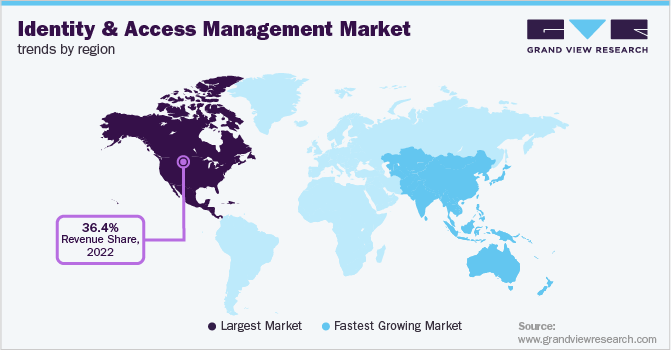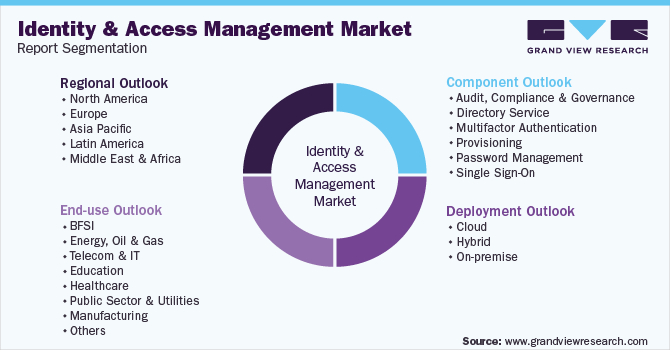- Home
- »
- Network Security
- »
-
Identity And Access Management Market Share Report, 2030GVR Report cover
![Identity And Access Management Market Size, Share & Trends Report]()
Identity And Access Management Market Size, Share & Trends Analysis Report By End-use (BFSI, Education), By Component (Directory Service, Provisioning), By Deployment (Cloud, On-premise), And Segment Forecasts, 2023 - 2030
- Report ID: 978-1-68038-564-9
- Number of Report Pages: 143
- Format: PDF, Horizon Databook
- Historical Range: 2018 - 2021
- Forecast Period: 2023 - 2030
- Industry: Technology
Report Overview
The global identity and access management market size was valued at USD 15.93 billion in 2022 and is projected to expand at a compound annual growth rate (CAGR) of 12.6% from 2023 to 2030. Identity and access management (IAM) assures that the appropriate person and job position (identities) in an organization have access to the tools they need to perform their duties. Identity management and access systems allow companies to administer employee apps without logging in as an administrator to each app. Advances in the internet of things (IoT) and artificial intelligence (AI), rising awareness about regulatory compliance management, increasing reliance on digital platforms & automation, and growing adoption of cloud technologies across industries are estimated to drive the market over the forecast period.

The rising cases of fraudulent and cybercrime activities are driving organizations to implement IAM systems as a result of the rapid adoption of the cloud and the advancement of new technologies. IAM uses identity analytics and intelligence to monitor unusual user account activity. In addition, it allows for the deletion of inactive accounts, the detection of policy violations, and the removal of inappropriate access privileges. Hence, the rising enterprise identity and security concerns drive the growth of the industry. Moreover, lower production costs make application administration effortless; the centralizing process time for connectivity and identity modifications increases user reliability, provides easier access to sign-in, signup, and user management processes for application holders, and implements procedures and policies related to user verification and prerogatives.
Furthermore, the integration of the IAM solution and mobile device Management (MDM) may utilize IAM more efficiently and enable the organization’s security and control. MDM is a critical component of IAM as it allows one to control apps and users on the device. Because IAM can be used on multiple devices, extending IAM to mobile devices is a must for any business. MDM is an essential component of IAM as it provides security and the ability to provision apps to devices. MDM collaborates with IAM to help protect each device and, as a result, create security for the user. Both IAM and MDM are critical to each other. MDM allows businesses to easily use identity and access management, while also providing control and security.
Businesses that choose this system will benefit, but they must be aware that to avoid vulnerable points, biometric solutions must be compatible with any smartphone. However, failure to store data, such as personal information and authentication credentials, may result in data breaches and digital identity fraud. Enterprise bring-your-own-device (BYOD) policies have made IAM systems more complicated. Furthermore, the high installation costs of these systems are expected to stifle the growth of the industry over the forecast period. The industry is adopting the latest IAM business technologies as capital technology. These technologies have increased market opportunities for IAM, which have been purchased and implemented in recent years.
IAM contracts' market revenue necessitates extensive implementation. Hence, cloud-based IAM services and technologies are becoming more accessible. These factors are estimated to create lucrative growth opportunities in the global market. The COVID-19 outbreak impacted several business sectors, including the access industry and individuals. Since COVID-19, internet services have played a significant role. Internet services made the population reliant on the growth of the IAM market. During the pandemic, access management software had a critical role in the growth of the overall industry.
Component Insights
On the basis of components, the global industry has been further categorized into audit, compliance & governance, directory service, multifactor authentication, provisioning, password management, and single sign-on. The provisioning sub-segment dominated the industry in 2022 and accounted for the largest share of more than 29.70% of the overall revenue. Identity management as a service provides an additional layer of security by identifying, validating, and granting individuals access to a company's information systems.
Hence, this promotes segment growth. The multifactor authentication sub-segment is anticipated to advance at the fastest CAGR over the forecast period. This sub-segment adds multi-layer security by requiring users to provide multiple identifying credentials and a user ID to access applications. The added layer of security enhances the overall security, which has resulted in the high adoption of multifactor authentication among various businesses operating in different industries, thereby driving the growth of the segment.
Deployment Insights
On the basis of deployment modes, the global industry has been further classified into cloud, hybrid, and on-premise. The on-premise deployment sub-segment led the market in 2022 and accounted for the largest share of more than 50.45% of the overall revenue, due to the functionality of the solution without the need for an external network connection and access through Wide-Area Network (WAN) too. The cloud-based sub-segment is anticipated to register the highest CAGR over the forecast period.
Cloud computing has many benefits for any business, such as controlling IT systems and lowering costs for repairing, faster access to data for continuing business as regular operations with fewer interruptions & productivity losses, and ensuring data backup & storage in a secure and safe location. For instance, in March 2021, according to ForgeRock, 80.0% of IT decision-makers have adopted, expanded, or plan to adopt cloud-based solutions. Thus, the rising adoption of cloud-based solutions by SMEs drives segment growth.
End-use Insights
On the basis of end-uses, the industry has been further classified into BFSI; energy, oil & gas; telecom & IT; education; healthcare; public sector & utilities; manufacturing; and others. The public sector & utilities end-use segment dominated the industry in 2022 and accounted for the maximum share of more than 25.00% of the overall revenue. Rising digitalization adoption, increased investment in public sector applications, and the presence of a large amount of public data that are to be stored are the factors driving the segment growth.

The BFSI segment is estimated to expand at the fastest CAGR over the forecast period. The growing popularity of online payments, e-wallets, and digital/retail banking is expected to increase the adoption of these types of solutions across the BFSI sector to ensure appropriate access to the right people, manage risks, and comply with security regulations. Manufacturing, education, IT & telecom, retail & consumer packaged goods, and energy & utilities are all expected to grow significantly over the forecast period.
Regional Insights
On the basis of geographies, the industry has been further categorized into Asia Pacific, North America, Europe, Latin America, and Middle East & Africa. North America dominated the global industry in 2022 and accounted for the largest share of more than 36.45% of the overall revenue. Increased cases of cyber-attacks faced by firms due to increased internet penetration are among the key driving factors for regional growth.

The rising demand for cybersecurity management and data safety is further expected to boost the region’s growth over the coming years. On the other hand, Asia Pacific is expected to register the fastest growth rate over the forecast period. Rising internet penetration, rapid digital infrastructure development, the presence of a large number of SMEs adopting such systems, and growing operational digitalization are all contributing to the development of the IAM market in the Asia Pacific region.
Key Companies & Market Share Insights
The global industry is highly competitive. Key players undertake various strategies, such as M&A, business expansions, and product portfolio expansions, to gain a higher market share. For instance, in May 2022, Microsoft announced the launch of a family of IAM named Entra. Entra includes its existing tools, such as Azure AD, with its new product, Decentralized Identity and Cloud Infrastructure Entitlement Management (CIEM). Entra is intended to safeguard access to any resource or application by allowing security professionals to detect and manage permissions in multi-cloud environments, allowing them to secure digital identities from end to end. Some of the prominent players in the global identity and access management market include:
-
Amazon Web Services, Inc.
-
Broadcom
-
One Identity LLC.
-
ForgeRock
-
HID Global Corp.
-
IBM
-
McAfee, LLC
-
Microsoft
-
Okta
-
OneLogin
-
Oracle
-
Ping Identity
-
SecureAuth
-
Evidian
-
Intel Corp.
Identity And Access Management Market Report Scope
Report Attribute
Details
Market size value in 2023
USD 18.09 billion
Revenue forecast in 2030
USD 41.52 billion
Growth rate
CAGR of 12.6% from 2023 to 2030
Base year for estimation
2022
Historical data
2018 - 2021
Forecast period
2023 - 2030
Quantitative units
Revenue in USD million/billion and CAGR from 2023 to 2030
Report coverage
Revenue forecast, company ranking, competitive landscape, growth factors, and trends
Segments covered
Component, deployment, end-use, region
Regional scope
North America; Europe; Asia Pacific; Latin America; Middle East & Africa
Country scope
U.S.; Canada; U.K.; Germany; France; Italy; Spain; China; India; Japan; Australia; South Korea; Brazil; Mexico; Argentina; UAE; Saudi Arabia; South Africa
Key companies profiled
Amazon Web Services, Inc.; Broadcom; One Identity LLC.; ForgeRock; HID Global Corp.; IBM; McAfee, LLC; Microsoft; Okta; OneLogin; Oracle; Ping Identity; SecureAuth; Evidian; Intel Corp.
Customization scope
Free report customization (equivalent to up to 8 analysts’ working days) with purchase. Addition or alteration to country, regional & segment scope.
Pricing and purchase options
Avail customized purchase options to meet your exact research needs. Explore purchase options.
Global Identity And Access Management Market Segmentation
This report forecasts revenue growth at the global, regional, and country levels and provides an analysis of the latest industry trends in each of the sub-segments from 2018 to 2030. For the purpose of this study, Grand View Research has segmented the global identity and access management market report on the basis of component, deployment, end-use, and region:

-
Component Outlook (Revenue, USD Million, 2018 - 2030)
-
Audit, Compliance & Governance
-
Directory Service
-
Multifactor Authentication
-
Provisioning
-
Password Management
-
Single Sign-On
-
-
Deployment Outlook (Revenue, USD Million, 2018 - 2030)
-
Cloud
-
Hybrid
-
On-premise
-
-
End-use Outlook (Revenue, USD Million, 2018 - 2030)
-
BFSI
-
Energy, Oil & Gas
-
Telecom & IT
-
Education
-
Healthcare
-
Public Sector & Utilities
-
Manufacturing
-
Others
-
-
Regional Outlook (Revenue, USD Million, 2018 - 2030)
-
North America
-
U.S.
-
Canada
-
-
Europe
-
U.K.
-
Germany
-
France
-
Italy
-
Spain
-
-
Asia Pacific
-
China
-
India
-
Japan
-
Australia
-
South Korea
-
-
Latin America
-
Brazil
-
Mexico
-
Argentina
-
-
Middle East & Africa
-
UAE
-
Saudi Arabia
-
South Korea
-
-
Frequently Asked Questions About This Report
b. The global Identity And Access Management market size was estimated at USD 15.93 billion in 2022 and is expected to reach USD 18.09 billion in 2023.
b. The global Identity And Access Management market is expected to grow at a compound annual growth rate of 12.6% from 2023 to 2030 to reach USD 41.52 billion by 2030.
b. North America dominated the Identity And Access Management market with a share of 36.49% in 2022. This is attributable to the favorable regulatory scenario in the region.
b. Some key players operating in the Identity And Access Management market include Oracle Corporation, IBM Corporation, CA Technologies, NetIQ Corporation (Micro Focus), HID Global Corporation.
b. Key factors that are driving the market growth include increasing implementation of IAM solution for business facilitation, improving operational efficiency, and increasing security concerns among organizations.
Share this report with your colleague or friend.
![gvr icn]()
NEED A CUSTOM REPORT?
We can customize every report - free of charge - including purchasing stand-alone sections or country-level reports, as well as offer affordable discounts for start-ups & universities. Contact us now
![Certified Icon]()
We are GDPR and CCPA compliant! Your transaction & personal information is safe and secure. For more details, please read our privacy policy.
We are committed towards customer satisfaction, and quality service.
"The quality of research they have done for us has been excellent."





